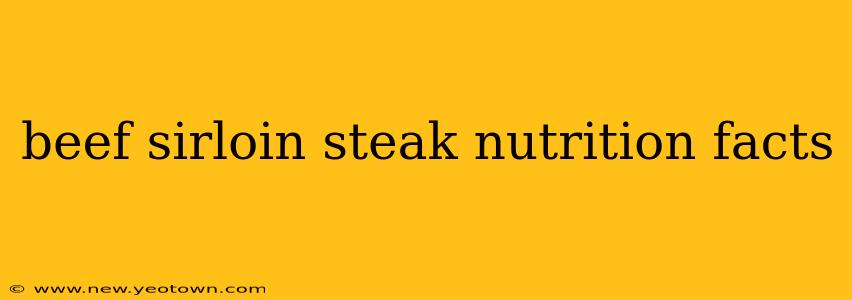The aroma of a perfectly seared sirloin steak, the juicy tenderness melting in your mouth – it's a culinary experience many crave. But beyond the delicious taste, lies a nutritional profile worthy of exploration. This isn't just a celebratory meal; it's a source of essential nutrients that contribute to a healthy and balanced diet. Let's dive into the nutritional facts surrounding this beloved cut of beef.
What are the nutritional benefits of beef sirloin steak?
Beef sirloin steak is a lean cut of meat, relatively low in fat compared to other cuts like ribeye or short rib. This leanness translates into a lower calorie count, making it a suitable choice for those watching their weight. However, don't mistake "lean" for "lacking nutrients." Sirloin boasts a significant amount of protein, crucial for building and repairing tissues, supporting a healthy immune system, and maintaining satiety. This protein is rich in essential amino acids, the building blocks our bodies can't produce on their own. Beyond protein, sirloin provides iron, a vital mineral for oxygen transport throughout the body, and zinc, essential for immune function and wound healing. It also contains B vitamins, contributing to energy production and nerve function.
How many calories are in a beef sirloin steak?
The calorie count in a beef sirloin steak varies significantly based on the size of the steak, the cut's specific leanness, and the cooking method. A 3-ounce serving of lean sirloin can range from approximately 150 to 200 calories. However, adding butter, oil, or rich sauces during preparation can significantly increase this number. It's always best to check the nutrition label of your specific product or use a nutrition tracking app to get a precise calculation for your chosen preparation method and portion size.
Is beef sirloin steak good for weight loss?
The lean nature of sirloin steak makes it a potentially valuable addition to a weight-loss diet. The high protein content promotes fullness, helping to curb hunger and prevent overeating. However, weight loss is a multifaceted process. Combining sirloin with a balanced diet and regular exercise is key. Over-consuming sirloin, regardless of its leanness, could still lead to weight gain due to the calorie density of meat. Portion control remains crucial for achieving and maintaining a healthy weight.
How much protein is in a beef sirloin steak?
A 3-ounce serving of lean sirloin steak typically provides around 25-30 grams of protein. This substantial amount makes it an excellent source of this essential macronutrient. This high protein content is particularly beneficial for athletes, individuals engaged in strength training, and those aiming to build or maintain muscle mass. The protein in sirloin contributes to feeling full and satisfied, supporting weight management goals.
What are the potential downsides of eating beef sirloin steak?
While offering significant nutritional benefits, consuming sirloin steak regularly does come with certain considerations. Firstly, the fat content, though lower than in some cuts, should still be factored into a balanced diet. Secondly, red meat consumption has been linked to increased risks of certain health conditions, including heart disease and some types of cancer. Moderation is key; integrating sirloin into a diet rich in fruits, vegetables, and whole grains helps mitigate potential risks. The high saturated fat content should be considered for those with specific health concerns. Always consult with a doctor or registered dietitian to determine the appropriate amount of red meat for your individual needs.
Conclusion: Enjoying Sirloin Responsibly
Beef sirloin steak provides a valuable contribution to a healthy diet when consumed in moderation and as part of a balanced eating plan. Its high protein content, essential minerals, and B vitamins make it a nutrient-rich choice. However, awareness of its calorie and saturated fat content is necessary for informed consumption. Ultimately, enjoying this delicious cut of meat responsibly means making conscious choices about portion sizes and preparation methods, ensuring it contributes positively to your overall well-being.

